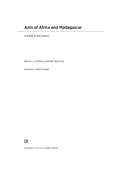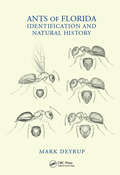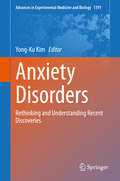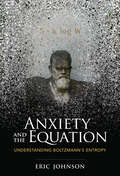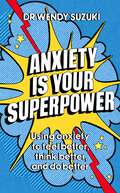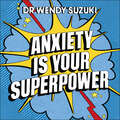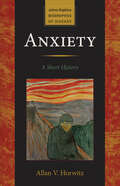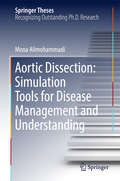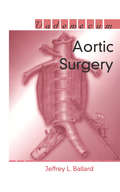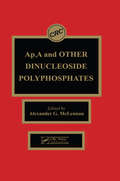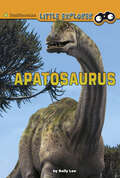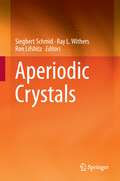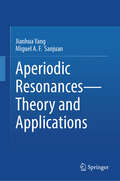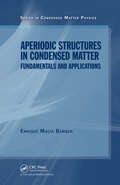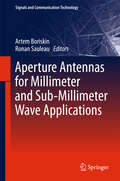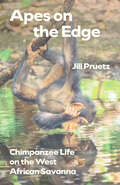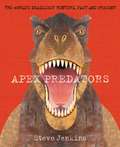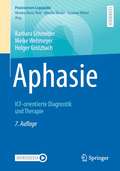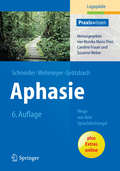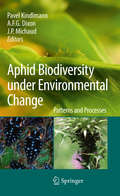- Table View
- List View
Ants of Africa and Madagascar: A Guide to the Genera
by Barry Bolton Brian L. FisherAcross the Afrotropical and Malagasy regions, ants are one of the most conspicuous and ecologically dominant animal groups. From driver ants to weaver ants, there are over 2,000 species in Africa alone and over 600 in Madagascar. Ants of Africa and Madagascar introduces readers to the fascinating and diverse ant fauna of the Afrotropical and Malagasy regions. Featuring illustrated keys to subfamilies, separate keys to Afrotropical and Malagasy ant genera, and distribution maps, it also describes diagnostic characters, explores ant ecology and natural history, and includes a list of all currently recognized ant species in the regions. This detailed guide is an essential tool for entomologists and myrmecologists working with and learning about this diverse population of Formicidae.
Ants of Florida: Identification and Natural History
by Mark DeyrupAnts are familiar to every naturalist, ecologist, entomologist, and pest control operator. The identification of the 233 species of Florida ants is technically difficult, and information on Florida ants is dispersed among hundreds of technical journal articles. This book uses detailed and beautiful scientific drawings for convenient identification. To most Florida biologists ants are currently the most inaccessible group of conspicuous and intrusive insects. This book solves the twin problems of ant identification and the extraordinary fragmentation of natural history information about Florida ants.
Anxiety Disorders: Rethinking and Understanding Recent Discoveries (Advances in Experimental Medicine and Biology #1191)
by Yong-Ku KimThis book reviews all important aspects of anxiety disorders with the aim of shedding new light on these disorders through combined understanding of traditional and novel paradigms. The book is divided into five sections, the first of which reinterprets anxiety from a network science perspective, examining the altered topological properties of brain networks in anxiety disorders. The second section discusses recent advances in understanding of the neurobiology of anxiety disorders, covering, for example, gene-environmental interactions and the roles of neurotransmitter systems and the oxytocin system. A wide range of diagnostic and clinical issues in anxiety disorders are then addressed, before turning attention to contemporary treatment approaches in the context of novel bio-psychosocial-behavioral models, including bio- and neurofeedback, cognitive behavioral therapy, neurostimulation, virtual reality exposure therapy, pharmacological interventions, psychodynamic therapy, and CAM options. The final section is devoted to precision psychiatry in anxiety disorders, an increasingly important area as we move toward personalized treatment.Anxiety Disorders will be of interest for all researchers and clinicians in the field.
Anxiety and the Equation: Understanding Boltzmann's Entropy
by Eric JohnsonA man and his equation: the anxiety-plagued nineteenth-century physicist who contributed significantly to our understanding of the second law of thermodynamics. Ludwig Boltzmann's grave in Vienna's Central Cemetery bears a cryptic epitaph: S = k log W. This equation was Boltzmann's great discovery, and it contributed significantly to our understanding of the second law of thermodynamics. In Anxiety and the Equation, Eric Johnson tells the story of a man and his equation: the anxiety-plagued nineteenth-century physicist who did his most important work as he struggled with mental illness. Johnson explains that “S” in Boltzmann's equation refers to entropy, and that entropy is the central quantity in the second law of thermodynamics. The second law is always on, running in the background of our lives, providing a way to differentiate between past and future. We know that the future will be a state of higher entropy than the past, and we have Boltzmann to thank for discovering the equation that underlies that fundamental trend. Johnson, accessibly and engagingly, reassembles Boltzmann's equation from its various components and presents episodes from Boltzmann's life—beginning at the end, with “Boltzmann Kills Himself” and “Boltzmann Is Buried (Not Once, But Twice).” Johnson explains the second law in simple terms, introduces key concepts through thought experiments, and explores Boltzmann's work. He argues that Boltzmann, diagnosed by his contemporaries as neurasthenic, suffered from an anxiety disorder. He was, says Johnson, a man of reason who suffered from irrational concerns about his work, worrying especially about opposition from the scientific establishment of the day. Johnson's clear and concise explanations will acquaint the nonspecialist reader with such seemingly esoteric concepts as microstates, macrostates, fluctuations, the distribution of energy, log functions, and equilibrium. He describes Boltzmann's relationships with other scientists, including Max Planck and Henri Poincaré, and, finally, imagines “an alternative ending,” in which Boltzmann lived on and died of natural causes.
Anxiety is Your Superpower: Using anxiety to think better, feel better and do better
by Dr Wendy SuzukiWe live in an age of anxiety. Like an omnipresent yet invisible odour you've grown used to, anxiety has become a constant condition, a fact of life, and a distraction that undermines our quality of life. Dr Wendy Suzuki's ground-breaking research will show us that science tells us a very different story: yes, anxiety is unpleasant - it's meant to be - and in the debilitating extreme, what Wendy will call 'bad anxiety', it's destructive. But most of the anxiety that humans feel is essential - not only to survival, but for higher brain functions formerly thought to be put on hold during anxious moments, Wendy will provide two broad categories of neuroscience-based hacks for harnessing anxiety and facing it head-on. The first will help address and calm anxiety so that you can enjoy the productivity you will experience, and the second grouping of brain science hacks will enable readers to channel anxious feelings into six uses for good anxiety - from productivity, increased emotional intelligence and focus to creativity and confidence. Through Wendy's unique perspective as a neuroscientist, she will teach us how to flip anxiety on its head and offer a counterintuitive lens through which to understand how anxiety manifests in our everyday lives. The book will introduce a taboo breaking slant on anxiety: we will learn how it can be good for us and that once we learn how to play it at its own game, it can become our superpower!
Anxiety is Your Superpower: Using anxiety to think better, feel better and do better
by Dr Wendy SuzukiThis is cutting-edge science packaged as a practical guide on how to flip anxiety on its head and harness it as a superpower - by world-renowned neuroscientist, Dr Wendy Suzuki.We live in an age of anxiety. Like an omnipresent yet invisible odour you've grown used to, anxiety has become a constant condition, a fact of life, and a distraction that undermines our quality of life. Dr Wendy Suzuki's ground-breaking research will show us that science tells us a very different story: yes, anxiety is unpleasant - it's meant to be - and in the debilitating extreme, what Wendy will call 'bad anxiety', it's destructive. But most of the anxiety that humans feel is essential - not only to survival, but for higher brain functions formerly thought to be put on hold during anxious moments, Wendy will provide two broad categories of neuroscience-based hacks for harnessing anxiety and facing it head-on. The first will help address and calm anxiety so that you can enjoy the productivity you will experience, and the second grouping of brain science hacks will enable readers to channel anxious feelings into six uses for good anxiety - from productivity, increased emotional intelligence and focus to creativity and confidence. Through Wendy's unique perspective as a neuroscientist, she will teach us how to flip anxiety on its head and offer a counterintuitive lens through which to understand how anxiety manifests in our everyday lives. The book will introduce a taboo breaking slant on anxiety: we will learn how it can be good for us and that once we learn how to play it at its own game, it can become our superpower! (P)2020 Hodder & Stoughton Limited
Anxiety, Stress, and PTSD
by Stephen M. Stahl Meghan M. GradyThe Stahl's Illustrated books are a series of pocket-sized, mid-priced, themed volumes. They distil theoretical information from the Stahl's Essential Psychopharmacology volume and combine this with practical data from The Prescriber's Guide. They are illustration heavy and designed to encourage speedy learning of both concepts and applications. The visual learner will find that these books make the concepts easier to master, and the non-visual learner will appreciate the clear, shortened text on complex psychopharmacological concepts. This volume covers the latest developments in our understanding of post-traumatic stress disorder and anxiety. As well as covering the full range of management options, there is a specific focus on the implications for military populations. The Stahl's Illustrated series appeals to the widest possible audience of mental health professionals, and not just those with expertise in psychopharmacology.
Anxiety: A Short History (Johns Hopkins Biographies of Disease)
by Allan V. HorwitzFears, phobias, neuroses, and anxiety disorders from ancient times to the present.More people today report feeling anxious than ever before—even while living in relatively safe and prosperous modern societies. Almost one in five people experiences an anxiety disorder each year, and more than a quarter of the population admits to an anxiety condition at some point in their lives. Here Allan V. Horwitz, a sociologist of mental illness and mental health, narrates how this condition has been experienced, understood, and treated through the ages—from Hippocrates, through Freud, to today.Anxiety is rooted in an ancient part of the brain, and our ability to be anxious is inherited from species far more ancient than humans. Anxiety is often adaptive: it enables us to respond to threats. But when normal fear yields to what psychiatry categorizes as anxiety disorders, it becomes maladaptive. As Horwitz explores the history and multiple identities of anxiety—melancholia, nerves, neuroses, phobias, and so on—it becomes clear that every age has had its own anxieties and that culture plays a role in shaping how anxiety is expressed.
Aortic Dissection: Simulation Tools for Disease Management and Understanding (Springer Theses)
by Mona AlimohammadiThis thesis addresses computation fluid dynamics modelling of aortic dissection (AD), in order to generate in silico diagnostic information and assess 'virtual surgery' outcomes. The thesis introduces several important advances in the modelling of aortic dissection and lays essential groundwork for further development of this technology. The work thesis represents a unique and major step forward in our understanding of AD using a patient-specific, systematic and coherent simulation approach, and is currently the most advanced work available on AD.
Aortic Surgery
by Jeffrey L. BallardThis book reviews the pathogenesis, epidemiology, and screening for heart and stroke risk. It also focuses on the approach and specific treatment strategies for routine and complex aortic pathology, utilizing innovative surgical repair. Aortic Surgery is a handy reference for the clinician and trainee and offers critical insight into the complexities of aortic diseases through the knowledge of acknowledged experts in the treatment of aortic disease.
Ap4a and Other Dinucleoside Polyphosphates
by Alexander G. McLennanAp4A and Other Dinucleoside Polyphosphates is the first compilation of contributions from major investigators involved in studying the chemistry and biology of dinucleoside polyphosphates. The book features reviews and original research (including unpublished and anecdotal material) covering the whole area of dinucleoside polyphosphate research from its inception to the present day. Ap4A and Other Dinucleoside Polyphosphates will be a useful reference for biological scientists studying nucleotide metabolism, cell signalling, DNA replication and repair, and cellular response to stress.
Aperiodic Crystals
by Ray L. Withers Ron Lifshitz Siegbert SchmidAperiodic Crystals collects 37 selected papers from the scientific contributions presented at Aperiodic 2012 - the Seventh International Conference on Aperiodic Crystalsheld held in Cairns, Australia, 2-7 of September 2012. The volume discusses state-of-the-art discoveries, new trends and applications of aperiodic crystals - including incommensurately modulated crystals, composite crystals, and quasicrystals - from a wide range of different perspectives. Starting with a general historical introduction to aperiodic crystals, the book proceeds to examine the complex mathematics of aperiodic long-range order, as well as the theoretical approaches aimed at understanding some of the unique properties and mechanisms underlying the existence of aperiodic crystals. The book then explores in detail such topics as complex metallic alloys, modulated structures, quasicrystals and their approximants, dynamics, disorder and defects in quasicrystals. It concludes with an analysis of quasicrystal surfaces and their properties. By describing the latest research and the progress made on the structure determination of aperiodic crystals and the influence of this unique structure on their physical properties, this book represents a valuable resource to mathematicians, crystallographers, physicists, chemists, materials and surface scientists, and even architects and artists, interested in the fascinating nature of aperiodic crystals.
Aperiodic Order: A Mathematical Invitation
by Michael Baake Uwe GrimmQuasicrystals are non-periodic solids that were discovered in 1982 by Dan Shechtman, Nobel Prize Laureate in Chemistry 2011. The underlying mathematics, known as the theory of aperiodic order, is the subject of this comprehensive multi-volume series. This first volume provides a graduate-level introduction to the many facets of this relatively new area of mathematics. Special attention is given to methods from algebra, discrete geometry and harmonic analysis, while the main focus is on topics motivated by physics and crystallography. In particular, the authors provide a systematic exposition of the mathematical theory of kinematic diffraction. Numerous illustrations and worked-out examples help the reader to bridge the gap between theory and application. The authors also point to more advanced topics to show how the theory interacts with other areas of pure and applied mathematics.
Aperiodic Resonances - Theory and Applications
by Miguel A. Sanjuan Jianhua YangThis book presents various types of aperiodic resonances in the form of a complete theoretical framework for the first time. It makes aperiodic resonance be a new disciplinary direction. In addition to the achievements in existing papers, the book proposes some new methods and discovers some new phenomena about different aperiodic resonances in nonlinear systems. The book includes theoretical analysis methods and their applications in three typical engineering backgrounds. It links theoretical researches on physical phenomena with different engineering problems. It aims to solve engineering problems from a new perspective based on aperiodic resonance theories.
Aperiodic Structures in Condensed Matter: Fundamentals and Applications
by Enrique Macia BarberOne of the Top Selling Physics Books according to YBP Library ServicesOrder can be found in all the structures unfolding around us at different scales, including in the arrangements of matter and in energy flow patterns. Aperiodic Structures in Condensed Matter: Fundamentals and Applications focuses on a special kind of order referred to as aperiod
Aperture Antennas for Millimeter and Sub-Millimeter Wave Applications (Signals and Communication Technology)
by Artem Boriskin Ronan SauleauThis book presents the technology of millimetre waves and Terahertz (THz) antennas. It highlights the importance of moderate and high-gain aperture antennas as key devices for establishing point-to-point and point-to-multipoint radio links for far-field and near-field applications, such as high data-rate communications, intelligent transport, security imaging, exploration and surveillance systems. The book provides a comprehensive overview of the key antenna technologies developed for the mm wave and THz domains, including established ones - such as integrated lens antennas, advanced 2D and 3D horn antennas, transmit and reflect arrays, and Fabry-Perot antennas - as well as emerging metasurface antennas for near-field and far-field applications. It describes the pros and cons of each antenna technology in comparison with other available solutions, a discussion supplemented by practical examples illustrating the step-by-step implementation procedures for each antenna type. The measurement techniques available at these frequency ranges are also presented to close the loop of the antenna development cycle. In closing, the book outlines future trends in various antenna technologies, paving the way for further developments. Presenting content originating from the five-year ESF research networking program 'Newfocus' and co-authored by the most active and highly cited research groups in the domain of mm- and sub-mm-wave antenna technologies, the book offers a valuable guide for researchers and engineers in both industry and academia.
Apes and Human Evolution
by Russell H. TuttleIn this masterwork, Russell H. Tuttle synthesizes a vast research literature in primate evolution and behavior to explain how apes and humans evolved in relation to one another, and why humans became a bipedal, tool-making, culture-inventing species distinct from other hominoids. Along the way, he refutes the influential theory that men are essentially killer apes--sophisticated but instinctively aggressive and destructive beings. Situating humans in a broad context, Tuttle musters convincing evidence from morphology and recent fossil discoveries to reveal what early primates ate, where they slept, how they learned to walk upright, how brain and hand anatomy evolved simultaneously, and what else happened evolutionarily to cause humans to diverge from their closest relatives. Despite our genomic similarities with bonobos, chimpanzees, and gorillas, humans are unique among primates in occupying a symbolic niche of values and beliefs based on symbolically mediated cognitive processes. Although apes exhibit behaviors that strongly suggest they can think, salient elements of human culture--speech, mating proscriptions, kinship structures, and moral codes--are symbolic systems that are not manifest in ape niches. This encyclopedic volume is both a milestone in primatological research and a critique of what is known and yet to be discovered about human and ape potential.
Apes on the Edge: Chimpanzee Life on the West African Savanna (Animal Lives)
by Jill PruetzA moving story of survival and an eye-opening introduction to an extraordinary community of chimps and people. Fongoli chimpanzees are unique for many reasons. Their female hunters are the only apes that regularly hunt with tools, seeking out tiny bush babies with wooden spears. Unlike most other chimps, these apes fear neither water nor fire, using shallow pools to cool off in the Senegalese heat. Up to 90 percent of their home range burns annually—the result of human hunting or clearing for gold mining—and Fongoli chimpanzees have learned to predict the movement of such fires and to avoid them. The study of Fongoli chimps is also unique. While most primate research occurs in isolated reserves, Fongoli chimpanzees live alongside humans, and as primatologist and anthropologist Jill Pruetz reports, this shared habitat creates both challenges and opportunities. The issues faced by Fongoli chimpanzees—particularly food scarcity and environmental degradation—are also issues faced by their human neighbors. This connection is one reason Pruetz, who has studied Fongoli apes for over two decades, created the nonprofit Neighbor Ape in 2008 to provide for the welfare of the humans who share their landscape with apes. It is also why Pruetz decided to write this book, the first to offer readers a view of these chimps’ lives and to explain the specific conservation efforts needed to help them. Incorporating stories from Pruetz’s time in the field, including the compelling rescue of a young chimp from poachers, Apes on the Edge opens a fascinating window into primate research, conservation, and the inner workings of a very special population of our closest nonhuman relatives.
Apex Predators: The World's Deadliest Hunters, Past and Present
by Steve JenkinsWhat does it take to be the “top dog”? In his latest book, the award-winning author and illustrator Steve Jenkins introduces readers to apex predators—the animals that are at the top of their food chains and have no natural enemies. Using his signature art style, Jenkins illustrates how these animals dominate their different ecosystems using speed, strength, and even cooperation and cunning. Take a trip through history and discover apex predators both past and present, from the earliest sea creatures to the modern African lion and giant freshwater ray, which can grow to over fifteen feet.
Apex Predators: The World's Deadliest Hunters, Past and Present (Into Reading, Trade Book #2)
by Steve JenkinsNIMAC-sourced textbook
Aphasia Therapy: Historical and Contemporary Issues (Psychology Library Editions: Neuropsychology #7)
by David Howard Frances M. HatfieldOriginally published in 1987, Aphasia Therapy surveys the approaches to aphasia treatment from throughout the world that have been taken both in the past and in the present day. The authors critically examine the assumptions underlying different approaches, and show their effects on modern clinical practices. Finally, the book offers new perspectives on some contemporary issues in aphasia therapy, the effectiveness of treatment, and the relationship between an analysis of a patient’s problems and the processes of treatment. Aphasia Therapy is divided into three parts: Part 1 illustrates some approaches to treatment in the period up to World War II – for instance, a didactic approach which emphasised the importance of repetition; the second part considers the different kinds of approaches to therapy that have developed since then – seven "schools" of treatment are identified; Part 3 considers whether there is evidence that treatment of aphasia is effective: the authors argue that in future, aphasia treatment must involve the development and evaluation of specific treatment methods that are theoretically motivated by a coherent analysis of the individual patient’s problems. Students, postgraduates, and practising clinicians in speech therapy will find this volume of great interest, as will neuropsychologists and clinical psychologists.
Aphasie: ICF-orientierte Diagnostik und Therapie (Praxiswissen Logopädie)
by Barbara Schneider Meike Wehmeyer Holger GrötzbachDas erfolgreiche Lehrbuch in der 7. Auflage vermittelt Lernenden und Lehrenden in der Logopädie Grundlagen und evidenzbasiertes Wissen für eine Therapie von Aphasie nach ICF. Die detaillierte Beschreibung spezifischer Beeinträchtigungen, z.B. von Alexien, Agraphien und Akalkulien, ermöglicht eine umfassende Diagnostik und Therapie kommunikativer Störungen nach Schlaganfall. Hinweise zur Phase der Rehabilitation und zu Erholungsprozessen des Gehirns helfen gezielt bei der Planung und Durchführung der Aphasietherapie.Zu den einzelnen Störungsbereichen wie beim Sprachverständnis, der Wortfindung oder des Wortabrufs oder der Satzbildung finden Therapeuten bewährte Übungen, Hilfen und ausgewähltes Übungsmaterial. Auch auf Krankheitsbewältigung, soziale Integration und berufliche Reintegration wird eingegangen.Die 7. Auflage wurde umfassend überarbeitet und um zahlreiche Themen ergänzt, z.B. Bildgebung und Neuromodulation, partizipationsorientierte Diagnostik, Methoden der Unterstützten Kommunikation und technologiegestützten Aphasietherapie. Plus: Exkurse ermöglichen gezielt eine thematische Vertiefung.Ein Standard für die Behandlung von Patienten mit Aphasie für Auszubildende und Studierende der Logopädie sowie bereits erfahrene Sprachtherapeutinnen und Sprachtherapeuten zum Nachschlagen und Vertiefen.
Aphasie: Wege aus dem Sprachdschungel (Praxiswissen Logopädie)
by Barbara Schneider Meike Wehmeyer Holger GrötzbachPlötzlich sprachlos sein …… heißt für viele Patienten mit Aphasie, in einem „Dschungel“ aus Buchstaben, Wörtern und Sätzen sich zurechtfinden zu müssen. Welche Wege können Sie als Sprachtherapeut gemeinsam mit Ihren Patienten einschlagen, um sie aus diesem Dickicht zu führen, damit eine Teilhabe an Gesprächen und am sozialen Leben wieder möglich ist?Dieses erfolgreiche Lehrbuch – inzwischen in der 6. Auflage – vermittelt Ihnen die einzelnen Schritte dieses Weges in einer ausgewogenen Mischung aus Hintergrund- und Praxisinformationen. Sie erhalten alle für die Therapien erforderlichen Kenntnisse über Symptome und Syndrome, Anamnese und Diagnostik, Planung und Durchführung der Behandlung. Unterschiedliche Therapiebausteine unterstützen Sie dabei, für jede Störung individuell angepasste Übungen mit „Regieanweisungen“ durchzuführen, Hilfestellungen zu leisten und Materialempfehlungen umzusetzen.NEU in der 6. AuflageLangzeitverlauf von Aphasie bei Kindern und JugendlichenNeue ScreeningverfahrenEinsatz von PCs und TabletsKommunikativ orientierte Aphasietherapie
Aphid Biodiversity under Environmental Change: Patterns and Processes
by J. P. Michaud Pavel Kindlmann A.F.G. DixonThis book presents completely novel, yet unpublished findings on aphid population dynamics and ecology in the context of recent environmental changes and closely related issues. It can be used as complementary text in any course on population dynamics and ecology of crop pests at undergraduate or graduate levels. The book is intended mainly for graduate students, researchers in crop science, crop protection, agricultural advisors and managers, but it will surely attract attention of many other people interested in insect pests, their biological control and ecology.
